.jpg)
Hello there folks. I know it's been an eternity since one of these substantial and value for money(!) blog posts on all great things matte related, but I have had other things to do, such as home renovation work after the destructive cyclone and floods here last January (yes, it took 7 months for the damned insurance to come through... with 50'000 odd claims, most far more serious than ours!)
That aside, as mentioned ad nauseam over the fourteen or so years that these bloggings have been rolling off the cyber presses, I've just got to be in the exact mood to tackle 'em. It's a matter of waking up and the somewhat rusty brain issuing instructions that 'Today, is indeed the day'. I could never work to a 'deadline' type scenario.... simply does not compute I'm afraid.
Anyway, here we are, and what a 'bumper issue' as the saying goes that I have for rabid fans of traditional painted mattes, miniatures and old hand made cel animated gags that we all love so much (if you aren't a lover of this stuff, then this blog most definitely ain't for you!) None of that CGI crap here. It's all old style roll-your-sleeves-up, hand made, sweat-off-the-brow, gut instinct movie magic, just how they used to do it, and we just loved it.

Among the fabulous retrospectives on show here today - and I defy anyone to lay claim to have seen or even heard of 50% of the titles reviewed, such is my penchant for digging out lost and forgotten gold - I have a lushly extravagant MGM musical comedy; a long forgotten thirties disaster picture; a hokey feline spy thriller(!); a sweaty & lusty Brit potboiler; a very dark PG rated Disney flick; a taut James Stewart WWII drama; a run-of-the-mill Errol Flynn CinemaScope costumer; a now confirmed Albert Whitlock matte from long ago, AND, best of all, a long forgotten, filed away dossier of rare Jan Domela mattes and behind the scenes photos from many Paramount assignments I've never seen till now!!
So, if that isn't enough to wet one's appetite then I don't know what is.
Enjoy...
Pete
---------------------------------------------------------------------------------------------------------------------------
***This vast and utterly exhaustive post, and all 181 previous blog posts known as 'Matte Shot', were originally created by Peter Cook for nzpetesmatteshot, with all content, layout and text originally published at http://nzpetesmatteshot.blogspot.com/
---------------------------------------------------------------------------------------------------------------------
A PACKAGE OF LOST & REMARKABLE MATTES BY JAN DOMELA:
.jpg) |
| I am always grateful when somebody sends me artifacts or images that they know will tickle my proverbial fancy, and never more so than when a literal parcel is delivered to my mailbox (the actual mailbox, not the cyber one) from afar. The parcel in question was sent to me by the daughter of long, long, long time Paramount matte and glass shot artist Jan Domela, and contained a bounty of extremely rare, never seen before 35mm clips, tests and proof sheets. You can easily imagine the thrill for NZ Pete to have possession of such a treasure trove. **Photo top right shows Jan seated while effects cinematographer Irmin Roberts (at left) and an unidentified grip set up an in-camera glass shot on a location, circa 1930-33. More of that below... |
 |
Jan's daughter Johanna has been extremely helpful and generous over the years with a ton of old stills and transcribed letters of her Dad, and I cannot thank her enough. I have put together a selection of matte shots as enlarged from these 35mm trims (Nitrate!!! Somewhat a dodgy proposition in itself, though I'm certain that only those of us of a 'certain age' will even know what that amounts to).
Many of the later colour negs and trims from the sixties were in really bad shape, so couldn't be included, though here is a pretty fair representation of this lost collection, with most titles a mystery. |
 |
| On location, circa 1933 based on the ancient envelope included, with a 3 cent Geo.Washington stamp and 1933 postmark addressed to Domela at Paramount. Love this old stuff so much. Top left is Jan with matte camera minus mag. Middle pic is veteran Paramount effects cameraman Irmin Roberts, while at right we see Irmin setting a rough 'gaffer tape' outline upon the glass according to Jan's instructions as he lines up the prospective glass shot. |
 |
| Irmin Roberts, ASC with matte camera. Irmin had a mammoth career with Paramount, from around 1927 through to the 1960's, on big shows like THE TEN COMMANDMENTS, WAR OF THE WORLDS and one of the best vfx movies ever, George Pal's THE NAKED JUNGLE, with later forays into process cinematography and 2nd Unit on things like SHANE; IT'S A MAD, MAD, MAD WORLD; TORA, TORA TORA; AIRPORT and his last film, SOMETIMES A GREAT NOTION. Irmin was the inventor of the now popular 'reverse zoom' so-called trombone camera gag for Hitchcock's VERTIGO, and many years later utilised extensively by guys like Spielberg to brilliant effect in JAWS as Roy Scheider witnesses the shark eat the kid on the boogie board! |
 |
| The glass rigged awaiting for addition of painted elements. |
 |
| That may be Para's chief of effects, Gordon Jennings at left(?). Note the temporary 'shack' rigged around the glass to eliminate unwanted reflections etc. |
 |
| Glass matte art from both sides. Domela has painted in an array of buildings to conform to the cliff edge as well as a fleet of ships out in the bay. With these snapshots being taken out of line-up, the ships appear to be 'in the sky', but will all conform nicely for the final shot. |
 |
| An interesting snapshot at left of Domela by the 'grip truck' - in fact a studio car crammed to the limits with flats, supports, clamps, screws, rostrums, tripods, magazines, camera gear, and presumably the vital paints, brushes and turpentine! Shot at right shows Jan with his grip/assistant posing in front of finished glass painting. The actual on screen shot is shown below in a bit... |
 |
| Possibly Gordon Jennings at left. Jan at right eyeing up the shot. |
.jpg) |
| This 'old stuff' is absolutely fascinating to this writer/researcher. |
 |
| Before and after snapshots taken on a stills camera. See below....... |
.jpg) |
| The finished glass shot as it appeared in an unknown film. If anyone can i.d it, or any of the others featured below, then you know who to contact! |
%20sm.jpg) |
| One of the old 35mm trims was this nice shot from A FAREWELL TO ARMS (1932) |
.jpg) |
| A beautiful matte from a mystery film. |
.jpg) |
| Another from what looks like the same film. |
.jpg) |
| Cityscape painted in for mystery film? |
.jpg) |
| Very nice matted set extension from IF I HAD A MILLION (1932) |
.jpg) |
| Unknown |
.jpg) |
| Romantic Venice, as painted by Jan for, you guessed it, a mystery production, circa 1930-ish. |
.jpg) |
| Yes...the exact same shot, though it was hard getting a decent scan from the 35mm clip so I included 'em both. **Incidentally, just trying to buy a slide & neg scanner was a bloody nightmare. Tried (repeatedly) the utterly 101% useless Jeff Bezos' (Bozo more like it) Amazon - which used to be soooo reliable and user friendly (especially the UK store), but no more! Ordering from that godamned company is almost impossible these days, with the various order purchase steps, payment etc carried out only to get a notice after all that at the very end of the process "We are unable to ship to your country/destination. Please choose another destination". Yeah Jeff.... ship it to damned Uganda or Iceland and I'll pick it up from there! Wankers one and all at the pitiful Amazon! No I'm not making this up. |
.jpg) |
| With that off my chest, here's the same as a romantic moonlit scene. |
.jpg) |
| Forboding looking penitentiary by Jan Domela from an unknown picture. |
.jpg) |
| A wonderful matte, possibly from the same film? I also have various night views from the same setting. |
.jpg) |
| Unknown |
%20Jan%20Domela%20shot.jpg) |
| This one's a beauty... it's from GERONIMO (1939). The thirties and early forties are my favourite era's for matte shots. There was just a palpable sense of 'romance' to the art form that I still find utterly irresistible. |
.jpg) |
| Also unknown |
%20(sm).jpg) |
| Ahhh, this one I do know: LOVE ME TONIGHT (1932) |
.jpg) |
| Extensive painted additions, above the pedestrian's heads. Film a mystery though. |
.jpg) |
| I do wonder if this belongs to the film with those prison matte shots? |
%201.jpg) |
| This one I recognised from Paramount's DANGEROUS TO KNOW (1938) |
.jpg) |
| Not sure about this one? I did wonder if it might have been from SHANE (1953) ?? |
.jpg) |
| Several scope/anamorphic trims were in the package too, with a pair from this film that I failed to identify. With the colour all but gone I can't make out the supposed 'period' of the setting. Maybe Renaissance Italy or something? I know that Fox needed help and hired Jan to paint some mattes for the Charlton Heston epic THE AGONY AND THE ECSTACY in 1965, though I don't recognise this, nor the following shot as being from that film. May have been left on the cutting room floor? |
.jpg) |
| From the same film. I made a monochrome copy from the slide so as to better observe the setting, but to no avail sadly. |
.jpg) |
| Also included were a whole bunch of takes, tests and finals from the mammoth George Stevens epic THE GREATEST STORY EVER TOLD (1965) on which Jan worked on alongside Matthew Yuricich. Some fascinating clips, though mostly pretty much buggered as far as rejuvenating any form of colour. I'm always fascinated with out takes and tests such as these. The inscriptions scraped into the emulsion by Jan himself would be a means to keep a track of the process and repeat takes or rejects. |
.jpg) |
| An extremely rare look at one of Jan's paintings and takes that never appeared in the final print unless it did in the original very, very long cut as did other deleted mattes I have on file before the film was trimmed. |
 |
| Test frames from a superb matte that did make the cut, interestingly known as the 'gun sight shot Jerusalem' for some strange reason? |
 |
| Domela's final matte as it appeared in the BluRay edition of THE GREATEST STORY EVER TOLD. |
.JPG) |
| Some interesting notations made by Jan relating to some of the other shots he made, with references to "retake to eliminate dust", and make alterations to mountains etc. Fascinating and then some! |
Thank you for these wonderful artifacts Johanna. I do hope those misplaced before and after slides of Jan's work for VERTIGO turn up at some stage.
---------------------------------------------------------------------------------------------------------------------
DU BARRY WAS A LADY: a lavish Technicolor musical comedy from MGM
 |
| DU BARRY WAS A LADY (1943) was a funny, enjoyable romp, with a nice time travel twist. Grand production values, great mattes, eye-popping Gene Kelly dance routines and some amazing Tommy Dorsey orchestral showpieces, including a couple of fantastic Buddy Rich 'going crazy on his drums' bits that positively demand rewinding and repeat viewings! |
 |
| The cast were great, and even the usually 100% insufferable Zero Mostel had his moments to shine! |
 |
| Warren Newcombe was credited for 'special effects', though as was common knowledge, Warren never painted any of the shots himself. He was however, a grand manager and overseer when it came down to the high quality matte effects that came out of his incredibly talented stable of artists and cameramen, easily among the best the industry had at any one time. |
 |
| Top ups and grand ceilings etc were the bread and butter for budding matte exponents throughout the golden era of mainly studio sound stage bound movie production. |
 |
| A phenomenal matte out of Newcombe's department for DU BARRY WAS A LADY. I heard from Matthew Yuricich that during the war years many studio technicians were abroad fighting for the good, so studios were forced to hire temporary artists etc to fill the gaps, with many coming from a 'technical illustration' background. |
 |
| A spectacular matte composite. I always admired the MGM shots as the matte lines were almost always impossible to detect, with clever use and application of soft splits and expert blending. Mark Davis was chief matte cameraman, with key painters being Howard Fisher and Henry Hillinck among others. |
----------------------------------------------------------------------------------------------------------------------
JUDGMENT AT NUREMBERG - Confirmation of Matte Artist
 |
| The brilliant and powerful Stanley Kramer picture JUDGMENT AT NUREMBERG (1961) has long had me wondering who painted the sole matte shot which opens the film. Now we can confirm Albert Whitlock provided this shot, as I had suspected all along, as per a set of typed documents found among the papers held by Syd Dutton. |
-----------------------------------------------------------------------------------------------------------------------
THE LAST DAYS OF POMPEII - Making the earth move, 1930's style
 |
| Pretty much the entire crew and trick shot talent behind the legendary KING KONG and it's sad sequel SON OF KONG were on board for THE LAST DAYS OF POMPEII (1935). Note, the publicity paste up's above were somewhat more exciting than anything the film delivered, such was film promotion of the day. |
 |
| Hand coloured front-of-house stills like this probably did wonders, probably made for a re-issue. Scenes like this were scripted but dumped due to budget concerns sadly. Tremendous and substantial cut and paste job here by some ambitious publicity guy. |
 |
| Likewise, a mind blowing, though way over the top PR job again. Incidentally, Cooper and Schoedsack had initially intended to make the film in Technicolor, but the cost was just too great. |
 |
| The great Willis O'Brien headed up the creative team of KONG veterans such as glass shot artist Byron Crabbe and optical supervisor Vernon Walker. Harry Redmond had a key role in the physical aspects of the destruction, while uncredited miniaturist Gus White and matte cameraman Clarence Slifer - both KONG staffers - played an important role as well. |
 |
| Willis O'Brien with one of the miniature galleons built for POMPEII. For readers unfamiliar (I find that hard to comprehend!), O'Bie was a certified genius in the pantheon of visual storytelling, with many hats to his name, and as many unfinished projects as there were finished and celebrated films. O'Bie did some amazing trick work even before his monumental classic KING KONG in 1933, with things like the never completed CREATION and the spectacle THE LOST WORLD - both silents from the twenties. O'Bie was a visionary, a talented artist, sculptor, stop-motion animator, cameraman, modeller and matte painter. He had a grasp of all aspects of the 'fantastic' and how to create the impossible. Sadly, Willis was often sidelined, over ruled and eventually put out to pasture, despite his enormous talents, with later shows and dodgy producers simply cashing in on his name to sell a picture, many of those 'B' at best. So many future effects guys owe their lot to the great Willis H. O'Brien (go on...you know who you are!) |
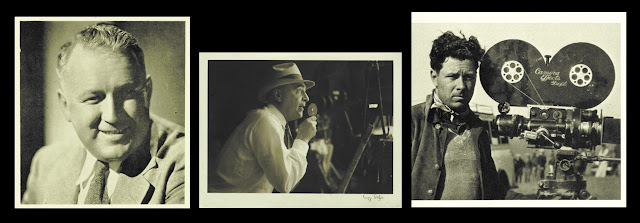 |
| Three key players in RKO's 'Camera Effects Department'. Left: Vernon Walker. Mid: Willis O'Brien. Right: Linwood Dunn |
 |
| O'Bie, as he was known, shows off two of the miniature sets built by Gus White, another KONG alumni. |
 |
| Matte painter Byron Crabbe at work on a vast glass shot of the Gladiatorial arena that would ultimately not be fully utilised to it's best advantage in the film, unfortunately. Byron would paint on many films around the thirties, often with friend Jack Cosgrove on various projects. Crabbe started designs for matte work on GONE WITH THE WIND under Cosgrove, but died suddenly during pre-production. |
 |
| A pre-production concept sketch rendered by Mario Larrinaga who had a solid association with O'Bie and Crabbe, going way back. |
 |
| O'Bie with cameraman Eddie Linden who acted as both production cinematographer and overall effects cinematographer on POMPEII as he did on KONG, which was quite unusual for the time, and rarely occurred at all even after the fact! |
.jpg) |
| A nice relaxed moment for O'Bie and his miniatures unit, one of whom must be W.G 'Gus' White who made the memorable model sets for KING KONG. |
 |
| RKO's resident sculptor, Italian born artisan John Cerasoli and his hand made figurines aboard the Roman vessel. John did similar assignments for the two KONG films with skillfully sculpted figures and tiny props. |
 |
| The opening shot was this multi-layered optical/matte with various planes of glass art, projected smoke, real water and a foreground with actors added as a travelling matte element, possibly via the Dunning double matting process. |
 |
| Before and after multi-plane glass shot from an article in a technical magazine of the day, I think it was Popular Mechanics which occasionally had this sort of article. |
 |
| Byron Crabbe's rendering of Pompeii combined with water shot off San Pedro. This original production blow up is good, but the shots when seen in the film were less crisp. With the many exposures required once the live action was added with the people on the boat, the shot suffered with excessive grain and contrast, which was unavoidable due to the number of runs through Linwood Dunn's optical printer. Cinematographer Eddie Linden wrote in American Cinematographer at the time about the visuals: "One of the first tasks was making the Vesuvius smoke and the threatening clouds. In the case of the smoke, we shot it in different ways at several different speeds ranging from four to twelve times the normal speed, and in shades ranging from black & white, and just a thin, lazy wisp, to a magnificent roaring volume. Thousands of feet of negative were exposed on smoke alone. At 700 feet or more per minute it doesn't take long to run up a lot of footage! Then we would get into a huddle in the projection room and pick the best takes to use in our various composite shots. You'd be surprised at just how much argument there is in just plain smoke!" |
 |
| The title page from an old 1935 issue of American Cinematographer where cameraman Eddie Linden explains the numerous processes used. I will include various quotes as captions henceforth. |
 |
| Glass shot of the Temple of Jupiter if I recall. |
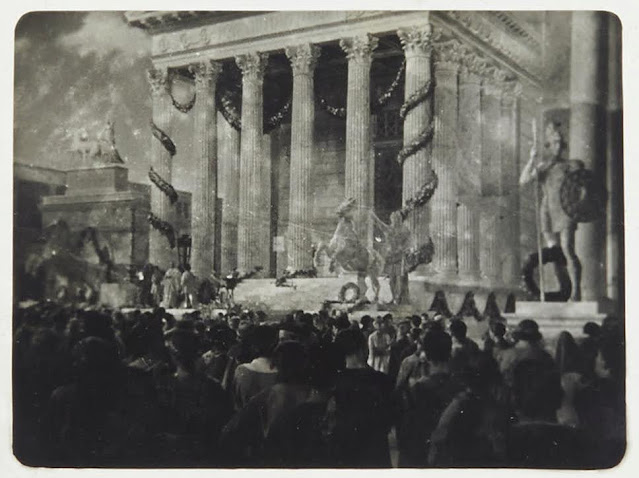 |
| Closer, sharper reproduction of the matte shot of the temple as seen in one of O'Bie's fx photos of 1935. |
 |
| Upper part of the frame painted in as a cost saver and to hide stage fixtures. |
 |
| An invisible matte painted set extension. See below... |
 |
| Before and after tells all. |
 |
| The spectacular Roman estate and sprawling hill suburbs of Pompeii as it appears on screen. |
.JPG) |
| The actual Roman estate large scale miniature by Gus White minus the matted in water. |
Note the painted background.
|
 |
| Meticulous detail on White's miniature. |
 |
| An excellent addition to a minimal set courtesy of Byron Crabbe's paint brush. |
 |
| A hauntingly atmospheric vista of literally Biblical proportions! |
 |
| Multi-element fx shot with actors added as a travelling matte component. At the time both the Williams Matting System and the competitor Dunning Double Printing System were in use in Hollywood, though which was employed for POMPEII I don't know. Both had their advantages, yet both had failings under certain conditions. |
.jpg) |
| A wider view of the Temple of Jupiter and the crowded square. See below for matte art!! |
.jpg) |
| An incredibly rare artifact here is this high resolution picture of the original Byron Crabbe glass painting for the above scene. I must thank profusely my fellow matte fan Steven way over there in New York for sending me this amazing image. Very much appreciated my friend. |
.jpg) |
| Close up of the detailed brushwork rendered by Crabbe. Magnificent. |
 |
| Not sure about the shot at left. May be a full set as too large a shot to be 1935 rear projected well, and no fringing detectable as a Dunning shot. Frame at right is a multi-layered vfx shot though. A miniature of the huge Colossus statue, a glass painted arena, projected 'people' in the stands, a smoke element also projected, and this all provided as a plate for the addition of the foreground action as a travelling matte. |
 |
| Composite shot down in the arena just before the shit literally hits the fan! |
.JPG) |
| Before and after with Gus White's miniature set etc. |
 |
| Crabbe at work on his arena glass painting which sadly is never shown to full advantage in the final cut. We only ever get to see a heavily cropped version with barely any matte art visible in the finished edit. The pic at right is a test that only appears in the film with much additional close foreground action obscuring the matte composite. The editor should have used a full cut before cluttering up the view. |
 |
| 'Thar she blows...' |
 |
| The volcanic blast and subsequent earthquake cause mayhem. Colossus cracks apart and falls upon the panicked Gladiators in this combination miniature/live action shot. |
 |
| Another of the KONG alumni, Clarence W. Slifer was on the unit for POMPEII. Slifer was matte cinematographer on the film and would go on to be a major 'backroom talent' on a hundred or so films at various studios over the next 45 years, as effects cameraman at Selznick International, 20th Century Fox and mostly at MGM, though rarely credited. According to his long time friend (and occasional nemesis) Matt Yuricich, Clarence just loved being in his optical room and devising new and improved systems for his optical printers and camera equipment. |
 |
| Members of Gus White and Harry Redmond's effects crew shoot high speed take of the Colossus biting the dust. |
 |
| A faded 1935 colour snapshot of Willis in front of the majestic Temple of Jupiter miniature, all carefully wired and rigged by Harry Redmond for what he hopes will be a successful demolition (it was!) |
.JPG) |
| O'Bie with loudspeaker shouts 'action' with his twenty man crew all knowing their roles. The model comes down by means of a mass of hidden wires and a series of concealed metal rods within the actual columns that could be literally slipped out in stages thus allowing the pre-scored column structure to self collapse. See below... |
 |
| An excellent composite with miniature starting to shake and a hundred Roman extras fleeing as a travelling matte element, probably through the Williams Matte Printing Process. As I understand it, such a wide shot would have needed a vast amount of orange light upon the actors, with a blue screen at the back, to facilitate hold out mattes through the Dunning Process. The alternative Williams Process could avail a more simple bright 'white' illuminated backing (or sometimes black) behind the actors to pull high contrast silhouette mattes which would later be combined as bi-pack elements. Later developments by Frank Williams - with John P. Fulton - utilised a blue screen backing and white lit actors. |
 |
| Cameraman Eddie Linden spoke about this in the 1935 American Cinematographer article on the film's effects: "One of the finest examples of miniature building was The Temple of Jupiter, constructed under the supervision of Willis O'Brien by Gus White and his assistants. It was one of those nerve-racking shots for it had to be made, and made right, in just one take. The slightest slip up on the part of any one of the 20 men who worked on this shot would mean weeks of hard work rebuilding and re-shooting the scene, not to mention the thousands of dollars extra spent by the studio". |
 |
| Linden: "We made tests of all of the effects shots except the actual crash of the temple - the most important effect and the only one we couldn't test'. |
 |
| Linden: "Thanks to the efficiency of Harry Redmond's 'effecters', only minor changes were needed. A little less smoke here, a little more flame there, and so on. Then, the four cameras were again tested for steadiness, as the real people and the horses had to be processed in later, and even a movie earthquake couldn't explain a background that jiggled while the foreground didn't". |
 |
| Linden: "The tests were made and projected, and the final minute changes are made. Zero hour is now at hand. The order 'Hit 'em' is given by Willis. The lights blaze on. Flames and fire pots are lighted. Hundreds of smoke pots are timed electrically. Everything is ready". |
 |
| Linden: "Camera! Let 'er go. The rocking motion of the quake starts. The wires start the building to crumble, and 'go' she does". |
 |
| Linden: "Aaaah... all hands sigh with relief. Perfect the first time. Does it look real? There were some who saw the rushes who wouldn't believe it was done in miniature." |
 |
| A great full size physical effect by Harry Redmond as the ground opens up and swallows folks. Similar gags were applied by Fox in THE RAINS CAME (1939) and at MGM to outstanding effect in both SAN FRANCISCO the following year, and the epic GREEN DOLPHIN STREET in 1947 which deservedly won the Oscar for the effects work (as did the aforementioned Fox film). |
 |
| Pompeii's property values suffer a considerable slump! |
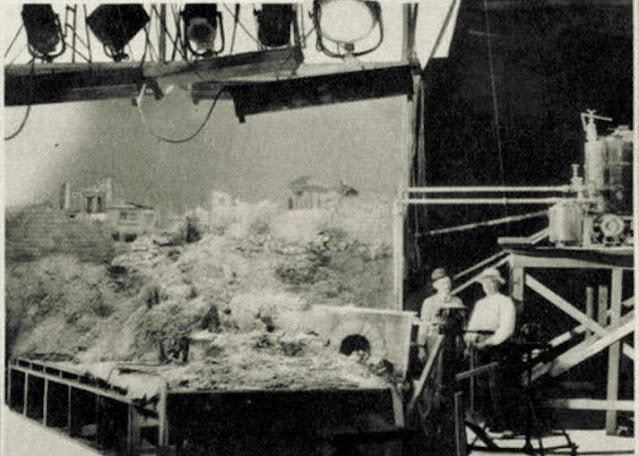 |
| A behind the scenes pic of O'Bie and associate on the miniature set all rigged up for the great outpouring of lava (note cylinders, piping and pumps at right). |
 |
| A still taken on the miniature set as the deluge of lava is unleashed. The final shot will include many additional elements such as smoke, fire, foreground debris falling and of course, actors, all assembled on Cecil Love and Linwood Dunn's optical printer under Vernon Walker's supervision. Lava frames to follow... |
 |
| Presumably a split screen shot with model destruction. |
 |
| Probably a full sized bit of mayhem? |
 |
| Another layered photographic effects composite with much going on. |
 |
| Eddie Linden wrote: "We had one scene in the film - the long shot of the destruction of Pompeii - which required seven separate exposures. Two were made at six times the normal camera speed; one at ten times normal; three were stop-motion exposures; and the seventh was a normal 24 fps shot. In any of these exposures camera movement, or even vibration, which would pass unnoticed in a normal shot, would have ruined the entire job as a complex effects shot". *Note= the stop-motion Linden mentioned wasn't animation per-se, but was frame by frame miniature rear projection of specific elements into shots. Pete |
 |
| Miniature action combined with travelling matted extras. In several instances some of the actors become 'invisible' or 'fade out' due to the inherent difficulties in pulling moving mattes from a vast crowd where blue (or orange) spill onto actors would bleed out parts of the action. |
 |
| 'Pompeii............ oh the humanity'. Not unlike Gaza today as it is pummeled to death by it's illegitimate neighbour, though I digress |
 |
| The lava flow envelopes the citizens of Pompeii. |
 |
| Cleverly devised set up with stunt performers doubled into O'Bie's miniature destruction, with some rotoscoped lava wrapping over the people to good effect. |
 |
| The optical printer(s) and operators sure got a workout on LAST DAYS OF POMPEII. |
 |
| High speed photography with actors matted as a static matte shot behind some rocks. |
 |
| Unavoidable matte line fringing around the people, but the cuts are rapid and nobody really notices. |
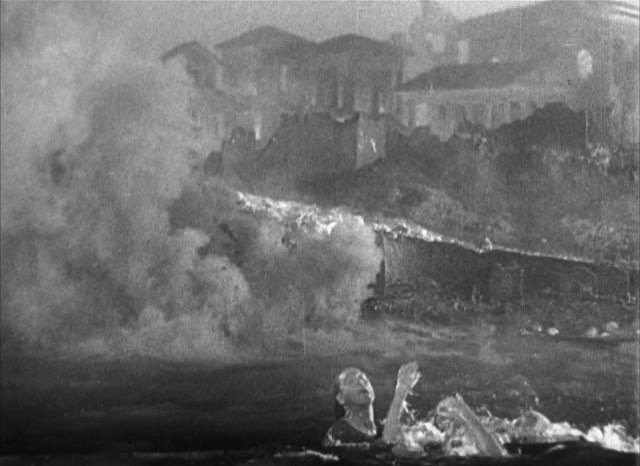 |
| Live action in a tank, combined with glass paintings and added smoke and fire. |
 |
| Large miniature collapses onto hapless doubled in extras with good final results. |
 |
| A highly complex shot, as explained by cinematographer Eddie Linden: "Unwanted camera movement of any vibration meant extreme care had to be taken with the cameras being conditioned, tested and tied down securely. We were fortunate in only having to make one take of this shot. We had to keep people from even walking across the stage floor when we were shooting! Ordinarily, a well constructed stage floor would be regarded as a pretty solid piece of construction, but our tests showed that ordinary footsteps walking across the stage floor produced enough vibration to endanger our shot. Therefore when we made our shot, we had to rope off the stage so that nobody but the crew actually needed for the shot could approach within 30 feet of the cameras. The city and volcano, which were glass paintings, were lined up in their proper relation. The smoke, clouds and the foreground water were projected into their proper places by stop-motion rear projection. The flames - well some of them - were also projected in, and others were painted in on yet another glass, carefully lined up with the others. Of course partially silvered mirrors were employed in some instances, to simplify the physical grouping of all these various elements. Obviously, the shot had to be lined up very carefully, and many tests were made to make sure that the smoke didn't roll from the wrong place, or some other mis-alignment didn't occur". |
.JPG) |
| At left is O'Bie posing for a gag photo with a Marcel Delgado built marlin, which was intended as a part of the film where the Gladiator's arena gets flooded and this great swordfish goes amok. It never got filmed, though would have made a sensational bit, much like the lost spider canyon sequence that O'Brien did on KONG. |
-------------------------------------------------------------------------------------------------------------------------
THE WARRIORS, aka THE DARK AVENGER - in like Flynn
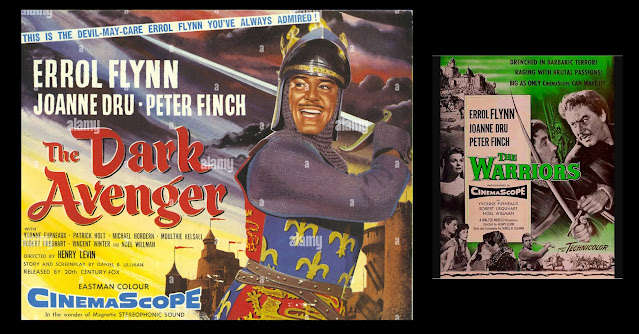 |
| Depending upon where you live, this film was released under two titles, THE DARK AVENGER and some prints as THE WARRIORS (1955). I presume the former title was the British and Commonwealth one as that's a UK Quad poster there at left. |
 |
| A minor though passable time filler with a good cast and quality production values, including several mattes in CinemaScope by person or persons unknown. I like Errol Flynn, and reckon OBJECTIVE BURMA was probably his best and most exciting film - even if it did stretch the truth somewhat. |
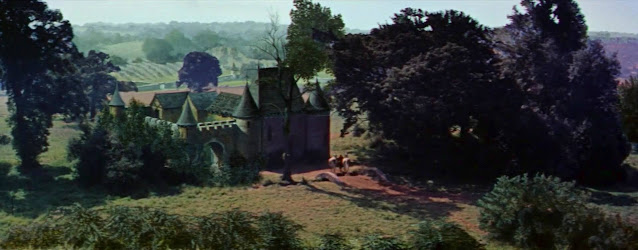 |
| Much matte painted detail in here, though no effects credit, the flick was a British made show so must have been assigned to either Wally Veevers at Shepperton, Cliff Culley at Pinewood, or, my best guess would be Tom Howard at MGM-UK. |
 |
| A very elaborate, almost full frame matte painted shot, with just a small slice of live action in the middle of the frame. I'd love to know who did the work. |
 |
| An expansive wide-screen matte of medieval battle and a rather flash homestead. See below for an interesting revelation... |
 |
| Top frame I recall I found in another fifties British period piece, KNIGHTS OF THE ROUND TABLE, which nicely matches to the identical setting as seen in THE WARRIORS-DARK AVENGER, though with extensive painted additions. The KNIGHTS picture was a Tom Howard job at MGM-Boreham Wood, so I suggest the latter film discussed here is also a Tom Howard assignment. If so, Tom's matte artist at the time was Judy Jordan. |
 |
| More quite extensive matte trickery where much of the setting has been added in with the painter's brush, including the entire foreground and castle. Peter Ellenshaw was always bold with this sort of thing - painting just about everything, right up to the tip of the audience's nose! |
 |
| Just a tiny sliver of actual film here in the middle of a sprawling matte painting. |
 |
| Partial set with painted extensions to flesh things out. |
-----------------------------------------------------------------------------------------------------------------------
THE MORTAL STORM - the rise of Fascism
 |
| A marvellous drama from MGM that still packs a punch today. THE MORTAL STORM (1940) tells of the stealthy rise of Nazism in the early thirties, Germany, and it's effects on various day to day folk. Beautifully acted and photographed. |
 |
| MGM's famed Newcombe department contributed several glorious shots to THE MORTAL STORM, mostly being various establishing shots of the small town and surrounds. |
 |
| A nice crane down shot over the church and onto the town was possibly a dual plane matte shot with the steeple etc painted on a foreground glass, or even more likely, a miniature foreground as there is a nice parallax shift as the camera moves down. |
 |
| A magnificent night matte of the James Stewart abode - a full matte painting with added smoke element. |
 |
| A later wider shot which looks like an actual 2nd unit plate with the central area painted in, possibly directly over a large photo blow up, which Newcombe's department did quite often. |
 |
| A brief miniature sequence with steam train rolling through the snow covered countryside. MGM's resident model genius was the incredibly talented Donald Jahraus who did jaw dropping work on so many films at MGM over his career, with Oscar winning fx shows like 30 SECONDS OVER TOKYO and GREEN DOLPHIN STREET being 100% standouts. |
 |
| Not sure about this beautiful shot. It may well be a straight out production shot with doubles for the actors, or some sort of extremely well done trickery. Probably the former. |
 |
| Now this is one sensational effects shot! The sun rises over the Austrian Alps. I don't have any idea how this was done. Possibly a miniature set with carefully controlled interactive 'sunlight' to cast a natural spread of light across the tips of the hills and trees, with shadows being the real deal? |
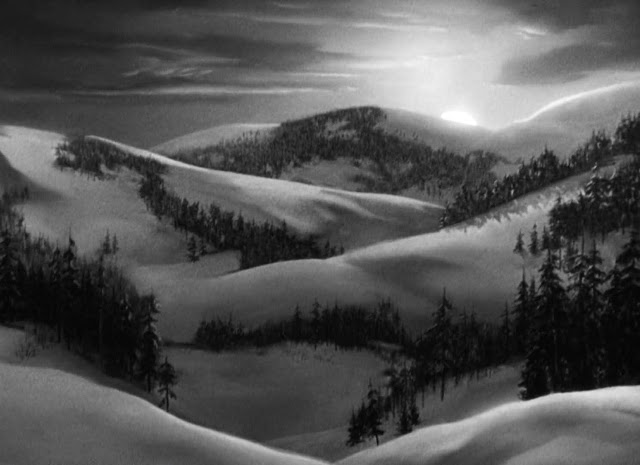 |
| A glorious vista during troubled times. |
 |
| Once again, most likely an actual location, secured as a large format photographic still, with the matte artist painting directly onto the enlargement the village etc. |
 |
| Same thing I suspect, with our leading man and friend skiing to freedom. Great film, well worth a look. |
-----------------------------------------------------------------------------------------------------------------------
SPY HUNT - Espionage with a feline twist
 |
| A bit hokey, but a generally satisfying Saturday night's viewing was SPY HUNT (1950) - a noir styled chase flick with danger at every front! |
 |
| Fairly minor, but had a number of good visual effects sequences including an excellent runaway train miniature and several matte shots, all supervised by David Stanley Horsley - a long time Universal photographic effects man who had worked at the studio since THE INVISIBLE MAN and FRANKENSTEIN back in the early thirties, through to all those trick filled ABBOTT & COSTELLO features and sci-fi flicks like THIS ISLAND EARTH. Horsley was called back in his old age to do some miniature shots for THE BATTLE OF MIDWAY in the mid seventies. |
.jpg) |
| The espionage scenario starts off with a couple of effective matte shots by Russell Lawson where an entire railway shunting yard has been painted in very effectively. |
 |
| Really an invisible trick shot. Note the smoke coming from the stack of the train down the track. |
 |
| A subsequent variation where the train has already passed by. Fine work by Russ Lawson. |
 |
| The plot revolves around a circus panther with some sort of highly desirable microfilm hidden in his collar, which the Commies want verrrry badly. The big pussycat is just the start of their problems! Shot here has a guy out back of the train unhooking the coupling to free up the wagon with the big cat. Nice travelling matte work, with guy nearly falling onto tracks. |
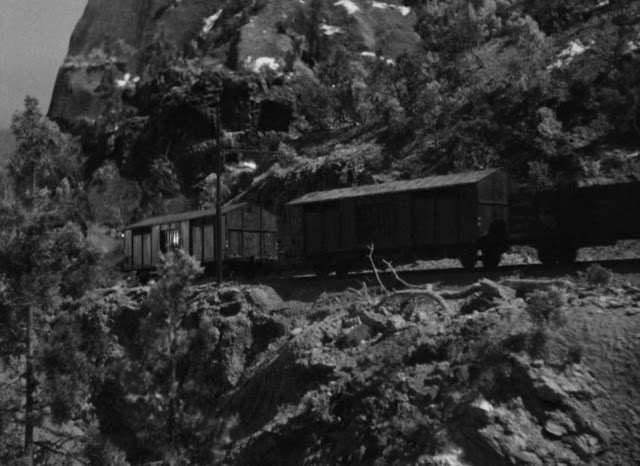 |
| The rear wagon is released. Outstanding miniature work by Universal's reliable Charlie Baker, who, along with other fx staffers, had been with the studio most of his life, from the 1930's right through to EARTHQUAKE in the seventies, and the last AIRPORT pictures. |
 |
| Models shot out in daylight was always the way to go for convincing shots. |
 |
| Possibly filmed by Horsley himself, or maybe Roswell Hoffman? |
 |
| Sadly, I never had a model train layout as a kid :( |
 |
| The train wagon looks a decent large scale. |
 |
| The wagon tumbles down the gully, and yes, you guessed it, the panther in question makes a dash for it, leading all manner of good guys and bad guys to seek out the aforementioned pussy (as one does!) |
 |
| Tracking down the cat, the isolated farm house holds a few secrets. **Note - it's always an issue trying to get acceptable matte grabs from older Universal films. Reason being that, firstly, the mattes are always dupe shots, thus a bit degraded to start with; and secondly it's almost always the case where mattes are establishing shots of one sort or other and inevitably occur within an optical dissolve - yet another layer of duped to death degradation of the original shot. A decent lab would intercut the awful duped dissolve quickly into the (interpositive?) original with just a slight flicker where one generation cuts to the other better generation, A&B rolls and all of that. Universal - shame on them - almost always 'held' the mega-duped matte from the dissolve literally until the action cut to a different shot/scene, thus we the viewer are stuck with the shittiest looking matte shot - no fault of the artist at all who must pull his hair out when it's screened. Worst of all is when you get a dissolve to a matte comp, and a superimposed title card over the top... that's like 4 fucken' generations! Take a look at the Audie Murphy war picture TO HELL AND BACK (1955) to see what I mean when they go to Rome!!! Having just watched a bluray of Uni's SIGN OF THE PAGAN and others, the otherwise competent matte painting work looks absolutely awful directly as a result of cheapskate lab practices. If I were the matte artist or fx cameraman of the day I'd leave a pile of burning dog shit on the doorstep of Technicolor labs, though as usual, I digress. |
 |
| Much treachery afoot in this seemingly homely mountain lodge. |
 |
| Howard Duff and Marta Toren spy the aforementioned panther down below in this multi-piece matte shot by Russell Lawson and Ross Hoffman. |
-----------------------------------------------------------------------------------------------------------------------
SOMETHING WICKED THIS WAY COMES - Not all the usual Disney sunshine & happiness.
 |
| Great poster art for a quite interesting, though not altogether successful 'adult' film from the Disney organisation which is worth rediscovery. In the most bizarre of coincidences, I was in communication just yesterday while in the midst of writing this, to Harrison Ellenshaw, who acted as vfx consultant on the picture. To our mutual amazement just a week or so ago the Disney Studio sent out an invitation to former staffers - one being Mr Ellenshaw - to come along to the screening room to view, oddly, the original unreleased rough cut of SOMETHING WICKED THIS WAY COMES not unspooled since 1982(!!) You can't make this stuff up! True story! |
 |
| Based on a Ray Bradbury story SOMETHING WICKED THIS WAY COMES (1982), has the feel of an old Rod Serling TWILIGHT ZONE type story stretched out to 96 minutes. That said, it's worth the time and showed a watershed moment when Disney went 'dark' and 'diabolical', and all the better for it. |
 |
| The effects miniatures unit with visual effects supervisor Lee Dyer at left and effects consultant Harrison Ellenshaw in the middle. The fellow at right escapes Harrison, to his embaressment. The miniature climax involved the entire Dark carnival being literally sucked up from the Earth to who-knows-where. The entire set was rigged on the ceiling, with structures and carnival rides all pre-set to fall away, though photographed inverted to provide the illusion of all and sundry sucked skyward. The photo at right shows Harrison finalising the quite extensive rigging required for the effects shoot. Incidentally, my pal Harrison found the film to be an utter 'snoozefest' - no matter which cut one sits through. |
 |
| Michael Lloyd was one of the two matte artists on the film. Michael is shown here painting on the later DICK TRACY. |
 |
| Jesse Silver was associate matte artist and contributed a number of vivid renderings. Some matte art was also done by Harrison Ellenshaw during Silver's absence due to illness. |
 |
| The film opens with an expansive rural matte painting as Tom Fury, played by actor Royal Dano - a wonderful and reliable old time character actor of 1000 westerns - drifts into the small town. Reportedly, some 16 or so mattes were painted for the film, though some evidentally never made the final cut. |
 |
| Same sequence, as Tom glances back over his shoulder to spy somewhat dodgy clouds moving on in. Matte painted shot with the actor added in, probably as a sodium vapour shot which Disney swore by. |
 |
| A follow up shot is a closer push in on the matte where it appears a great deal of the scene is in fact a painting. Disney almost always relied upon rear projected plates to form their matte shot composites, though often these were a bit washed out. |
 |
| The mysterious carnival arrives by steam train in the distance. Entirely an effects shot rendered as a complex series of some four painted glasses by artist Michael Lloyd and photographed in multi-plane fashion. The foreground houses were on the nearest glass; the the train on a second glass; the distant town on a third and the far horizon and sky on the forth glass. By using multiple glasses, a subtle simulated camera move inward was able to be carried out, allowing a natural looking perspective shift on the foreground artwork. Reportedly, initial expensive attempts to render the arrival as experimental early computer 'wireframe' generated animation failed and were done but rejected. Apparently, the bulk of the film had been shot and in the can as they say before any visual effects work was even planned, let alone commenced(!) |
 |
| A dramatic pull back shot from the carnival appears to be a multi-plane glass or miniature/painting combination. The last frame with the trees at the edges certainly looks like painted glass. |
 |
| A matte shot with the dark carnival in the fields which was the ultimate shot preferred over the initial version illustrated below. |
.jpg) |
| The elaborate fx scene that was abandoned. If the reader has a decent computer screen the original Cinefantastique caption would be so easily readable. |
 |
| The carnival holds a great many secrets and can grant one a wish or two. This one legged fellow will soon need to have twice as many socks to wash! See below... |
 |
| Don't say I never told you so.... Travelling matte with some roto articulation cured all his ills. |
 |
| Don't know about this... may be genuine, may be some of Mr Dark's mystical magic... or could be a bit of well executed Disney trickery? I suspect the latter. |
 |
| The Merry-Go-Round sequence was a ripper, and surprisingly creepy for a Disney show. Originally the sequence was done in a very straight forward fashion involving substitution of the actor each time the Carousel comes around. Deemed inadequate, later re-shoots were somewhat more complicated, with highly effective optical 'stutter' introduced to create a nightmarish cascade-like effect. The scene was designed by Lee Dyer and as far as I know, farmed out to an optical house called Symmetricon. Each individual 35mm frame was repeatedly superimposed with five consecutive frames, each at slightly different printer light values, which created an impressive strobe result. |
 |
| Other shots had the two boys matted into the foreground which lent an even more un-earthly feel to the event. |
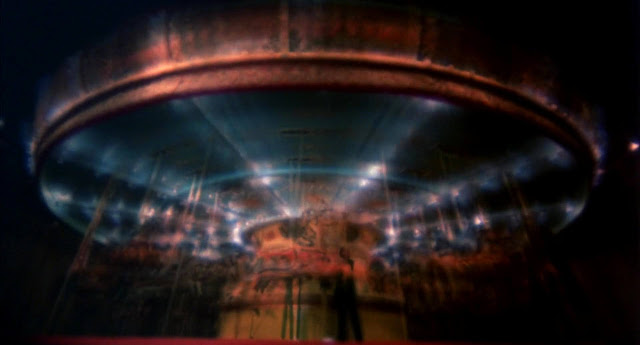 |
| Mr Dark, as played most effectively by Jonathan Pryce. Why is it that the best ever screen villains are played by Brit thespians? I'm thinking Laurence Olivier in MARATHON MAN; Richard Burton in 1984; Charles Laughton in MUTINY ON THE BOUNTY; Maurice Evans in PLANET OF THE APES; Herbert Lom (actually Hungarian) in every picture he appeared in... etc etc. |
 |
| Remember, this was the old photo-chemical days with optical printers and actual film (celluloid stuff with sprocket holes down both sides) |
 |
| Originally, the film had no planned visual effects, let alone elaborate optical jigsaws. |
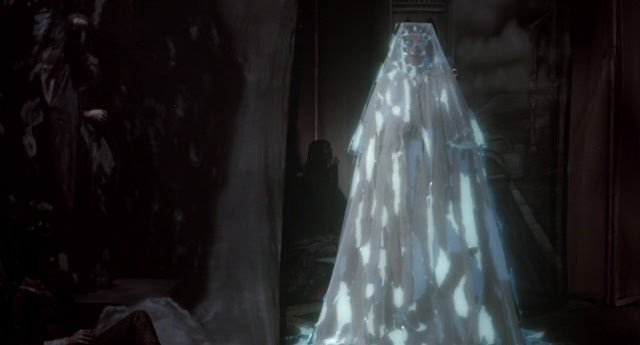 |
| One of my favourite actresses and queen of bad-ass cinema throughout the seventies, the incredible Miss Pam Grier shows up as a particularly mean spirited - some might say downright evil - the Dust Witch (you have a hell of a lot to live down if your parents named you Dust Witch!) |
 |
| In an elaborate vfx set piece, the Dust Witch sort of breaks free of what I suppose to be a glass tomb(?) Great cel animated effects work by Disney's animators. |
 |
| I'm an absolute sucker for old time hand drawn cel animated work. Disney, naturally, had the market cornered, and deservedly so. The cel work on things like 20'000 LEAGUES UNDER THE SEA; LT ROBINSON CRUSOE, USN; DARBY O'GILL & THE LITTLE PEOPLE; THE GNOME MOBILE and MARY POPPINS of course. I could watch those showreels back to back for a year! |
 |
| ...and here arriveth the incredible, though shamefully underused, Pam Grier, in all her magnificence (for now, at least). |
 |
| Pam... we love 'ya baby! |
 |
| No doubt a first for a Walt Disney picture... a character in the electric chair getting his brains fried. The film is set in the fictional Green Town.... more like the freakin' Green Mile thinks I. |
 |
| Pam is not one to be crossed! Believe me, I've seen all her movies!! |
 |
| A Michael Lloyd matte painting of the neighbourhood where some diabolical stuff goes down... |
 |
| A peek inside the matte room some years later when it became Buena Vista Visual Effects. Matte painter Paul Lasaine (with ponytail) shows new artist Justin Brandstatter some of the old mattes, including the Lloyd rendering of the house. In the video clip Paul is pointing out some odd perspective choices in the painting. *Note, on the wall behind is the surviving big Southern prison matte art from THE GREAT LOCOMOTIVE CHASE. |
 |
| Subsequent matte shots by Lloyd and Silver with animation doubled in. |
 |
| Now, this sequence, though subtle, I found most impressive. Mr Dark's Jonathan Pryce confronts Jason Robards and rips pages from a book, with each page bursting into a bright other-worldly glow. Great cel animated work by Gale Fox, who also added subtle interactive rotoscope 'glow' to the faces of the two actors. |
 |
| Traditional cloud tank physical effect combined with matte painted carnival and surrounds. This storm really means business. |
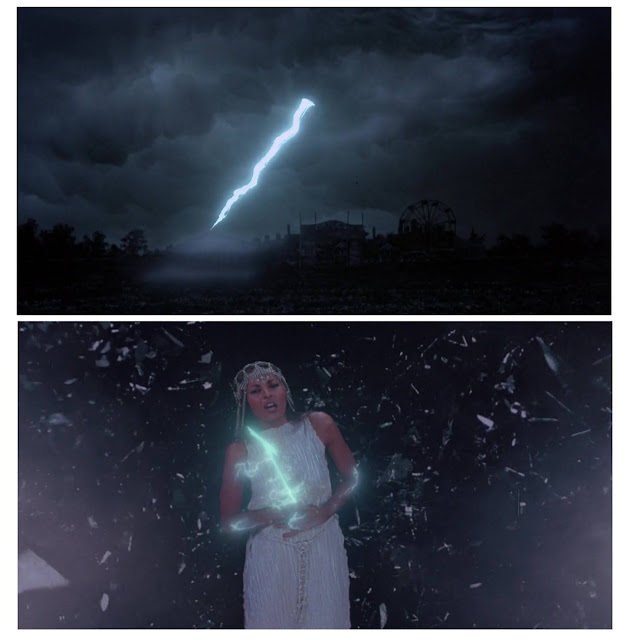 |
| The ever lovely Pam Grier gets a literal 'bolt from the blue', and is impaled on a lightning bolt. I couldn't actually figure out what this was all about, but here it is anyway... |
 |
| Pam proves utterly electrifying... |
 |
| Once again, some 'A-Grade' cel animated work. |
 |
| 'She wasn't all that tough after all, or so it would seem...' Mind you, in all her other flicks she's toting a pump action shotgun or 357 Magnum. Street vigilante Pam was far more resilient in days gone by than any stupid fantasy Dust Witch. 'Motherfuckers... watch out!' |
 |
| Probably a matte painted shot, with cloud tank footage added(?) |
 |
| Mr Dark's horrendously malfunctioning carousel goes completely banana's and self destructs. The best carousel out-of-control sequence since Hitchcock's brilliant STRANGERS ON A TRAIN many years ago. Classic! |
 |
| A most grisly demise for our Mr Dark, thanks in no small part to the Disney fx animation department. |
 |
| Originally planned and even filmed minus any visual trickery, and just animatronic and make up effects devices. Test screening to the exec's saw the vote to spice this (and much more) up considerably with optical and various trick shots. |
 |
| Oddly, first attempts to re-do with cel effects work were farmed to an outside provider due to the Disney people all tied up with mega-work on TRON. The sub-contractor's efforts were resoundingly rejected outright, and the shots were ultimately redone by Disney animation staff. |
 |
| Decidedly horrific for a Disney picture as Mr Dark's entire being deflates and dissolves away. Much animatronic puppeteering supplemented with optical overlays. |
 |
| Make up effects engineered by veteran Robert Schiffer. I miss the days of physical appliances, real on set make up fx and such like. Geniuses like the great Dick Smith, John Chambers, Jack Pierce, Rick Baker, Nick Maley, et al. Today's CG can't come close to stuff Dick Smith did on the actors in front of the camera. |
 |
| I guess it's just going to be one of those days! |
 |
| The entire Dark carnival self destructs in rather dramatic fashion, and, to put it crudely, literally disappears up it's own fundamental orifice(!) ;) |
 |
| Miniatures supervisor Harrison Ellenshaw perched atop a scaffold, high in the rafters of a Disney stage as he gives the "go" on the inverted destruction of the carnival. Shot high speed with 4 cameras, it looked good in the final film. |
 |
| An effective tornado, created in a large water filled tank, as per the standard system for years. Possibly some optical manipulation there later to further stir up the converging vortex and such like. |
 |
| Nice composite shot here with cloud tank physical effect combined via travelling matte by old time effects cameraman Art Cruikshank. Art had been with Disney since the days of FANTASIA, and worked on scores of films in an uncredited capacity. In the mid 1960's he moved over to 20th Century Fox and at last started to get some recognition. He provided grand optical cinematography duties for the Oscar winning FANTASTIC VOYAGE among many other Fox films. Art died shortly after completing his assignment on SOMETHING WICKED. |
 |
| Eerily atmospheric - no pun inferred - with excellent use of of sound editing to compliment the visuals. |
 |
| Terrific shot as the vortex sucks all to oblivion and beyond. |
 |
| Cloud tank presumably, combined with matte painting. The tank itself was some 9 feet wide, 6 feet deep and 6 feet high. The clouds and vortex were created by injecting standard Tempera paint in varying mixtures and configurations. |
 |
| All's well, that ends well. The morning after the night before where we are back in the lush storybook Disney environs we all remember as kids. An extensive matte painting combined with a VistaVision live action plate as a rear projected element, as per standard Disney photographic effects methods. |
 |
| Further, the camera pulls out for a wider view. Jesse Silver discussed the methods employed where he used airbrush techniques, oil pigments, acrylics as needed in his various mattes, from storm clouds to landscapes. Disney uses YCM separation masters - that is black & white records of the print system, yellow, cyan and magenta. Using separation masters the artists are able to re-balance and alter the colours in various ways to match the original live action plate. Disney was not an advocate of the original negative technique which arguably provides the finest results as all first generation is as good as it gets. Some early effects shows from the studio did work on the original negative such as DARBY O'GILL for some shots. |
 |
| The vfx people behind the scenes... |
.jpg) |
| I think I may have made vague mention of the legendary Pam Grier... sadly wasted (literally!) in SOMETHING WICKED with very little to do. Pam was the all out queen of 1970's action, blaxploitation & W.I.P cinema. Classics like THE BIG BIRD CAGE; COFFY; FOXY BROWN; FORT APACHE-THE BRONX; BEYOND THE VALLEY OF THE DOLLS; BUCKTOWN; THE ARENA; BLACK MAMA WHITE MAMA; THE BIG DOLL HOUSE and years later the decidedly mainstream Tarantino tribute piece, JACKIE BROWN and more!! They don't make 'em like that any more folks. Just the mere fact Disney hired her was a statement in itself. (*W.I.P= women in prison movies) |
-------------------------------------------------------------------------------------------------------------------------
SHE PLAYED WITH FIRE - FORTUNE IS A WOMAN: fooling around with the wrong gal.
 |
| The always reliable British actor, Jack Hawkins had his hands full with this 'fire-bug' babe in SHE PLAYED WITH FIRE (1957), which was also released as FORTUNE IS A WOMAN. |
 |
| An interesting little British potboiler with some effective matte shots painted by long experienced George Samuels, under the direction of old hand Wally Veevers. There were just a handful of trick shots, but I thought they were quite successful. |
 |
| I only have a DVD copy so I made the best I could of the effects shots. Top a nicely rendered set extension, pretty much half the frame painted in invisibly. Bottom, another effective shot where the mansion house and it's immediate surrounds have been added in by George Samuels. I had to replay that shot a few times to be sure it was what I thought it was (it was!) |
 |
| George had a long career with Shepperton Studios, initially as one of Percy 'Pop' Day's artists. When Day retired in the early fifties, Samuels became chief matte painter and oversaw a team of artists. Pop Day's former cameraman, Wally Veevers, would head the special photographic effects department. Samuels died suddenly in 1963 and was replaced by a young Doug Ferris. |
 |
| The chick that Jack is messing around with is a nut-job with a penchant for lighting fires. A good effects sequence where Hawkins escapes the conflagration as his stately home burns to the ground. The fire elements are separately shot and carefully matted into the windows. A brief shot lower right shows Jack's head pass under the otherwise undetectable matte line. |
 |
| Either a matte or a miniature of the destroyed mansion house, with Hawkins matted in. |
------------------------------------------------------------------------------------------------------------------------
**FINAL COMMENT:
My sincere thoughts and wishes go out to the Palestinian people, of the State of Palestine, as they are faced with the relentless genocidal destruction of their homeland and people, yet again.
The legitimate population of the State of Palestine have suffered endlessly since 1948, with the brutal, fascist jackboot of Israel pressed aggressively against their collective throats for over seven decades.
The swaggering sense of Israeli superiority, emboldened no doubt by their cocky self assurance as being the protected de-facto 51st State of America, whereby any and all extrajudicial acts and state sponsored multiple daily abuses of any and all normal accepted human rights are treated with utmost impunity - even in times of what could loosely be termed 'peace' - yet go, happily, unpunished, and are in fact, militarily supported.
Enough!
Pete
-----------------------------------------------------------------------------------------------------------------------
***This vast and exhaustive post, and all 181 previous blog posts known as 'Matte Shot', were originally created by Peter Cook for nzpetesmatteshot, with all content, layout and text originally published at http://nzpetesmatteshot.blogspot.com/



.jpg)

.jpg)
%20sm.jpg)
.jpg)
.jpg)
.jpg)
.jpg)
.jpg)
.jpg)
.jpg)
.jpg)
.jpg)
.jpg)
.jpg)
%20(sm).jpg)
.jpg)
.jpg)
%201.jpg)
.jpg)
.jpg)


.JPG)






.jpg)








.JPG)



.jpg)
.jpg)

.JPG)































.jpg)













.jpg)



























.jpg)

.jpg)





.jpg)
%20Jan%20Domela%20shot.jpg)
.jpg)
.jpg)
.jpg)
















.JPG)

.jpg)
.jpg)



.JPG)

.JPG)










.JPG)















































.jpg)




